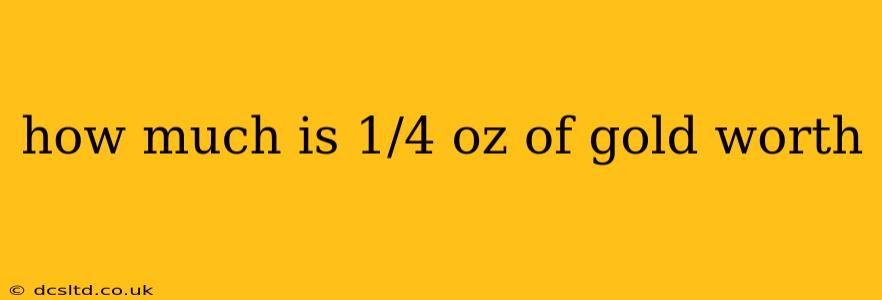Determining the precise value of 1/4 ounce of gold requires considering several factors beyond simply looking up the current gold price. While you can quickly find the spot price of gold per troy ounce (the standard unit of measurement for precious metals), the actual value you'll receive for selling 1/4 oz of gold will depend on several market nuances. This guide will break down the complexities and answer frequently asked questions about gold valuation.
What is the Current Spot Price of Gold?
The spot price of gold fluctuates constantly, influenced by global economic factors, market demand, and geopolitical events. You can find the most up-to-the-minute spot price on numerous financial websites specializing in precious metals. These websites typically display the price per troy ounce. To determine the approximate value of 1/4 oz, you would divide the spot price by four. However, this is only a preliminary calculation.
How is the Value of 1/4 oz Gold Determined?
The actual value you receive for selling your 1/4 oz gold will differ from a simple spot price calculation due to these key factors:
-
Gold Purity (Karat): Gold is rarely 24 karat (99.9% pure). Most gold jewelry and bullion bars contain alloys that increase durability and reduce cost. The higher the karat, the higher the gold content and, consequently, the higher the value. A 14k gold item will be worth less than a 24k item of the same weight.
-
Buyer's Fees and Premiums: Dealers, pawn shops, and gold buyers will charge fees or add premiums to the spot price. These fees cover their operational costs, profit margins, and the risk associated with handling precious metals. Premiums are typically higher for smaller quantities of gold like 1/4 oz.
-
Market Demand: Just like any commodity, the demand for gold can affect its price. High demand might push prices slightly above the spot price, while low demand could result in slightly lower offers.
-
Condition of the Gold: Damaged or heavily worn gold items will generally fetch less than pristine pieces.
What Affects the Price of Gold?
Several factors influence gold's price:
-
Inflation: During periods of high inflation, gold is often seen as a safe haven asset, leading to increased demand and higher prices.
-
Interest Rates: Changes in interest rates affect the relative attractiveness of gold compared to other investments.
-
Currency Fluctuations: The value of gold is often correlated with the US dollar, meaning a weaker dollar can lead to higher gold prices.
-
Geopolitical Events: Global instability and uncertainty can drive investors to gold as a safe haven, increasing demand and price.
How Can I Find the Best Price for My 1/4 oz Gold?
To maximize the value you receive, consider these tips:
-
Shop Around: Compare prices from multiple buyers (reputable jewelers, pawn shops, precious metal dealers).
-
Check Online Resources: Use online calculators that incorporate spot price, karat, and other relevant factors to give you a more realistic estimate. However, remember that these are estimates; the actual offer might vary.
-
Obtain an Appraisal: For items of significant value or uncertain purity, a professional appraisal can provide an accurate assessment before selling.
What are the Different Ways to Sell 1/4 oz of Gold?
You have several options for selling your gold:
-
Local Jewelers: Many jewelers buy gold, but their offers might be lower than specialized precious metal dealers.
-
Pawn Shops: Pawn shops offer a convenient but often less profitable option.
-
Precious Metal Dealers: These dealers specialize in buying and selling gold and typically offer more competitive prices.
-
Online Gold Buyers: Several online companies purchase gold, but always verify their legitimacy and security measures before sending your gold.
In summary, while the spot price provides a baseline, the actual value of your 1/4 oz gold will be determined by the factors discussed above. Always obtain several quotes and understand the terms and fees before making a sale.
